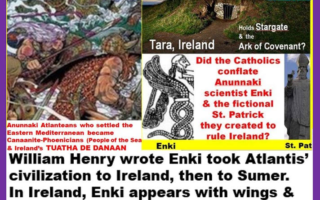Do you think Anunnaki DOMINATION Deprivations Marduk/Zeus & Enlil/Yahweh Dictated or PARTNERSHIP Perspectives Ninmah narrated will Prevail on the Planet?
https://www.youtube.com/watch?
This is a VIDEO; click the word “PARTNERSHIP” on the picture below to watch it.
From MARDUK, ANUNNAKI KING OF EARTH by Sasha Alex Lessin, Ph.D. (Anthropology, UCLA) & Janet Kira Lessin, CEO, Aquarian Media).
To get more about Cretan & other Anunnaki-spawned religions, click https://wp.me/p1TVCy-5zV
Minoan partnership culminated in Crete’s capitol, Knossos; Ninmah, the Anunnaki great goddess of Crete, gave us a partnership alternative to the domination mindset of Enlil & Marduk, Anunnaki Princes from the Planet Nibiru who had settled Iraq & Palestine.
Greek civilization developed among Bronze Age people descended from Crete’s Phoenician settlers. An Anunnaki couple–the Minos [King] may have been the Anunnaki sage Enki, whose mate, Ninmah, made sure Crete practiced partnership of the sexes.
5000 years ago, people from Crete’s partnership-oriented society settled in Athens, on Greece’s Attica Peninsula, where, from every direction, domination-driven Aryan refugees from the late Bronze Age Collapse joined them. To control the aggressive Greeks, the Minos invited the rulers of the Greek cities to send their young Greek kings-to-be & some princesses to Crete, where they trained as three-person teams, each with a bull with which they created vaulting shows for their hosts. The Greek kings whose heirs were, albeit honored, hostages, whose stay in the Knossos, the Cretan Capital, insured their friendliness & continuing trade.
“On Crete, where the Goddess was still supreme, there were no signs of war.” Cretans traced descent lines through women, not men. Crete, the last bastion of Ninmah’s partnership-based society, represented god as female. Even into the later Marduk/Zeus/Mycenean period in Greece, “Worship of Nature pervaded everything on Crete. Priestesses of the Goddess, not priests, played the central role in rituals.” Life on Crete “was permeated by ardent faith in Nature, the source of all creation & harmony. This faith led to the love of peace, a horror of tyranny & respect for the law. People of different racial stocks worked cooperatively for the common good. There was sharing of wealth” & a high standard of living even for peasants.”
The Minoan capital & port, “Knossos, had one hundred thousand inhabitants, streets paved & drained, fronted with neat three-story houses. Exercise & sports involve both men & women. Public ceremonies were primarily religious, processions, banquets & acrobatic displays, among them bull games in theaters & arenas. [Eisler: 30-31, 35-36, 43]
Ninmah preached sexual, ethnic & domestic partnerships. Her lands touted nonviolence, trade & travel. Her peaceful, unfortified cities lacked arms caches, armies, or enslaved people. People worshipped Ninmah across the Eastern Mediterranean islands in the Minoan Federation (named after the Minos, King of Crete).
Crete’s partnership society provides a model for the belief that “government should represent the interests of the people” rather than the rulers’.
The teams of Mainland Greek Royal Hostages—”Guests”—vaulted at rituals led by High Priestess Ariadne, High Priestess of Crete.
MYCENEAN GREEKS
The Dorian Greek underclass in northern Greece rebelled & dominated the Greek Myceneans at the beginning of the Bronze Age collapse, 1200 -1150 BCE. Perhaps Myceneans were part of the sea-going pirate bands known as the People of the Sea that ravaged the Mediterranean at the time, perhaps as a result of climate change, drought & massive wildfires like those we now experience due to astronomical influences. Some Myceneans settled in Cyprus.
Around 6000 BCE, immigrants from Ninmah’s fiefs in Anatolia “brought the Goddess.” For the next four thousand years, a lively and artistic lifestyle evolved that, in its highest form, evolved into the Goddess religion of Crete—a perk & a promise rather than a problem like that of the other Anunnaki-spawned religions.
“In 2000 BCE, Crete entered the Middle Minoan period when warlike male gods displaced the Goddess in the civilized world. People whom the Anunnaki influenced are still revered conflated with Hathor & Isis in Egypt, Astarte or Ishtar in Babylon, or Arina in Anatolia.” But Marduk-controlled areas considered Goddess Ninmah secondary–a consort or mother of more powerful male gods. Male dominance, wars of conquest & counter-conquest gripped most of Eurasia. Once nomadic people of the steppes got bronze weapons, they took Ninmah’s domains & spread war & Marduk’s influence in Europe & India.
But there were no signs of war on Crete where the Goddess was still supreme. Cretans traced descent lines through women, not men. Crete, the last bastion of Ninmah’s partnership-based society, represented god as female.
In Crete, even into the later Marduk/Zeus/Mycenean period, “Worship of Nature pervaded everything. Priestesses of the Goddess, not priests, play the central role in rituals.” Life on Crete “was permeated by ardent faith in Nature, the source of all creation & harmony. The partnership ideology led Cretinas to love peace, hate & avoid war, horror of tyranny & respect for the law. People of different racial stocks worked cooperatively for the common good.
The Minoan Capital & port, “Knossos, had one hundred thousand inhabitants, streets paved & drained, fronted with neat three-story houses. Exercise & sports involve both men & women. Public ceremonies were primarily religious, processions, banquets & acrobatic displays, among them bull games in theaters & arenas. [Eisler: 30-31, 35-36, 43]
Ninmah advocated sexual, ethnic & domestic partnership. Her lands touted nonviolence, trade & travel. Her peaceful, unfortified cities lacked arms caches, armies, or enslaved people. People worshipped Ninmah across the Eastern Mediterranean islands in the Minoan Federation (named after the Minos, King of Crete).
Crete’s partnership society gives us a model of the belief that “government should represent the interests of the people” rather than the rulers’ interests.”
ANUNNAKI & ANCIENT ANTHROPOLOGY EVIDENCE, REFERENCES, TIMELINE & WHO’S WHO
Evidence https://wp.me/p1TVCy-
References http://wp.me/
Timeline http://wp.me/p1TVCy-
Who’s Who http://wp.me/p1TVCy-1PE
Youtube re Partnership The Chalice or The Blade
Forward & share this post please.



